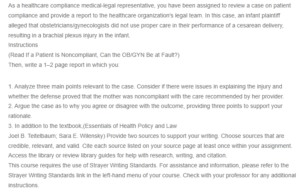Healthcare Compliance
The case presented is of an infant plaintiff faulting OB/GYN for improper care performance during a cesarian section. The three main points relevant to the case include the plaintiff’s allegations, the defendant’s perspective on the issue, and the issues around the birth process. The plaintiff alleges improper performance during a caesarian section and attributes the infant’s current presentation to this poor performance. According to the plaintiff, the brachial plexus injury that the infant sustained during the birthing process resulted from improper performance and non-compliance by the attending providers to the standards of care.
On the other hand, the defendant attributes the current infant’s presentation to factors of the plaintiff rather than the care process. In their explanation of the injury, the defendant makes a case for the impossibility of a brachial plexus injury resulting from cesarian delivery. Augustine et al. (2019) report that although cases of brachial plexus injury occur during the cesarian section, it is difficult to determine if these cases are attributable to the excessive force that often characterizes cesarian deliveries. The defendants further attribute brachial plexus injury seen on the infant to the plaintiff’s non-compliance with healthcare provisions. The plaintiff’s non-compliance with anti-asthma medications and consequent severe disease during pregnancy may have decreased oxygenation to the infant, resulting in nerve ischemia. According to Wang et al. (2021), prenatal hypoxia is a causal factor for abnormal brain development, impaired synaptic plasticity, general nerve ischemia, and consequential damage.
Moderate adhesion was encountered during the delivery process. This prompted a lower cesarian incision and manual extraction. Subsequent clavicular x-ray was positive for a birth trauma that the infant may have sustained during the manual extraction. Birth trauma remains a causal factor for brachial plexus injury. Van der Looven et al. (2019) attribute brachial plexus injuries to shoulder dystocia that occurs if excessive force is used on the infant during the delivery process. This mostly occurs in case of adhesions or restrictions in the pelvic region.
The claim was distinguished based on the opposing counsel’s inability to acquire an expert to support their theory. I agree with the outcome. From a legal perspective, the plaintiff’s claims did not have substantial grounds to merit their case. Significant in their submission was the absence of a certificate of merit to their verified complaint that affirmed they had consulted an expert before pressing the charges. This meant they had no basis for proving a breach of standards of care during infant delivery.
Significantly, the plaintiff’s presentation was non-compliant with healthcare instructions. The plaintiff disregarded multiple healthcare instructions. Prenatal records revealed that the mother was non-compliant with care recommendations and had failed to appear for serum screening, see a pulmonologist to review her asthma disease, and even present to the clinic for her scheduled cesarian appointment. The current presentation may have resulted from disregard for medical instructions. Nerve damage as a consequence of fetal ischemia has been implicated in infants born of asthmatic mothers. Additionally, delays in performing c-sections have been implicated in numerous birth injuries (Jansheski, 2021). This may have been the case in the case presented.
Another reason is the lack of a clear-cut nexus between the delivery process and brachial plexus injury. In as much as birth trauma was reported in the case, it does not necessarily become a causal factor for the brachial palsy injury seen in the infant. Augustine et al. (2019) report that it is difficult to determine whether a brachial plexus injury results from a cesarian delivery. In this regard, the plaintiff cannot prove beyond reasonable doubt that the infant’s presentation is a result of the provider’s poor performance.
References
Augustine, H. F. M., Coroneos, C. J., Christakis, M. K., Pizzuto, K., & Bain, J. R. (2019). Brachial plexus birth injury in elective versus Emergent Caesarean section: A cohort study. Journal of Obstetrics and Gynaecology Canada, 41(3), 312–315. https://doi.org/10.1016/j.jogc.2018.05.002
Jansheski, G. (2021, December 25). Delayed C-section and cerebral palsy: Medical malpractice. Cerebral Palsy Guidance. Retrieved November 12, 2022, from https://cerebralpalsyguidance.com/cerebral-palsy/causes/delayed-c-section/
Van der Looven, R., Le Roy, L., Tanghe, E., Samijn, B., Roets, E., Pauwels, N., Deschepper, E., De Muynck, M., Vingerhoets, G., & Van den Broeck, C. (2019). Risk factors for neonatal brachial plexus palsy: A systematic review and meta‐analysis. Developmental Medicine & Child Neurology, 62(6), 673–683. https://doi.org/10.1111/dmcn.14381
Wang, B., Zeng, H., Liu, J., & Sun, M. (2021). Effects of prenatal hypoxia on nervous system development and related diseases. Frontiers in Neuroscience, 15. https://doi.org/10.3389/fnins.2021.755554
ORDER A PLAGIARISM-FREE PAPER HERE
We’ll write everything from scratch
Question
As a healthcare compliance medical-legal representative, you have been assigned to review a case on patient compliance and provide a report to the healthcare organization’s legal team. In this case, an infant plaintiff alleged that obstetricians/gynecologists did not use proper care in their performance of a cesarean delivery, resulting in a brachial plexus injury in the infant.

Healthcare Compliance
Instructions
(Read If a Patient Is Noncompliant, Can the OB/GYN Be at Fault?)
Then, write a 1–2 page report in which you:
1. Analyze three main points relevant to the case. Consider if there were issues in explaining the injury and whether the defense proved that the mother was noncompliant with the care recommended by her provider.
2. Argue the case as to why you agree or disagree with the outcome, providing three points to support your rationale.
3. In addition to the textbook,(Essentials of Health Policy and Law
Joel B. Teitelbaum; Sara E. Wilensky) Provide two sources to support your writing. Choose sources that are credible, relevant, and valid. Cite each source listed on your source page at least once within your assignment. Access the library or review library guides for help with research, writing, and citation.
This course requires the use of Strayer Writing Standards. For assistance and information, please refer to the Strayer Writing Standards link in the left-hand menu of your course. Check with your professor for any additional instructions.

